Understanding Sept Stone Color and Its Significance
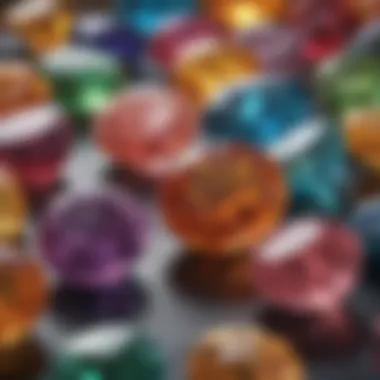
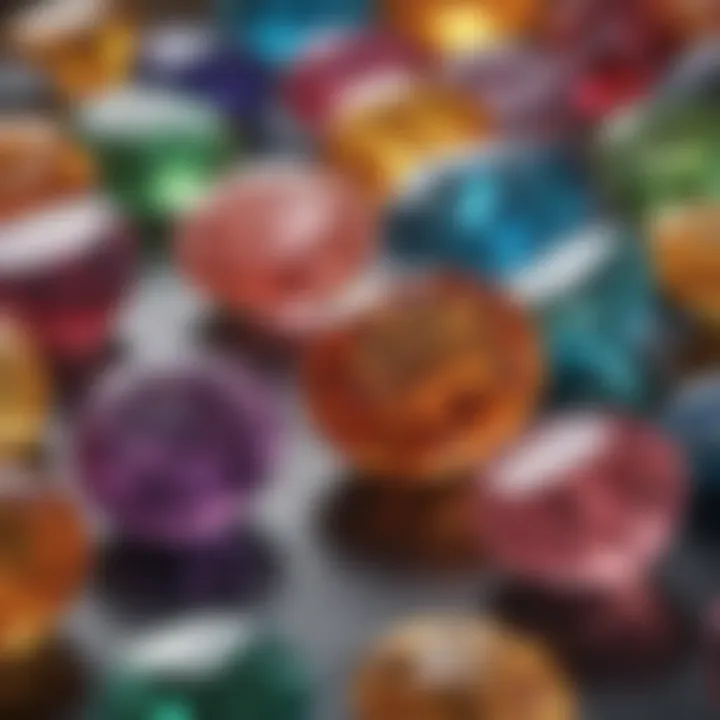
Intro
The world of gemstones is a captivating one, colored by myths, aesthetic appreciation, and cultural significance. One of the more intriguing aspects is the color of sept stones, which carries a breadth of meanings, steeped in history and personal symbolism. As we begin to delve into this concept, it becomes apparent that the color of these stones is not just a visual attribute but a reflection of deeper connections, both spiritual and emotional.
Gemstone enthusiasts and collectors alike often judge gemstones by their color, recognizing it as a critical factor in determining both beauty and value. However, understanding sept stone color extends far beyond a simple categorization; it brings to light the historical narratives and cultural meanings that accompany each hue. Colors can represent virtues like passion, tranquility, or even healing, resonating with those who wear or collect these stones.
Let's now embark on a journey that seeks to unlock the significance of these hues, exploring the rich tapestry that has woven together the art of jewelry design and the significance of every shade within the spectrum of sept stones.
Gemstone Overview
Definition of Gemstones
Gemstones, in essence, are naturally occurring minerals or materials that are cut and polished to be used in jewelry and decorative arts. Each gemstone holds its unique properties, be it physical, optical, or chemical. Some stones are valued for their rarity, while others might be cherished more for their cultural or historical significance.
Classification of Gemstones
There are several categories when classifying gemstones, generally divided into two main groups: precious and semi-precious.
- Precious Gemstones: Often considered the elite of gems, they include diamonds, rubies, sapphires, and emeralds. Their high value typically derives from their rarity and beauty.
- Semi-Precious Gemstones: While still beautiful and desirable, these include stones like amethyst, topaz, and garnets. Their variations in color and accessibility make them popular choices in jewelry making.
Furthermore, gemstones can also be categorized by their chemical composition, which includes
- Organic Gemstones (like pearls and coral)
- Inorganic Gemstones (like quartz and opal)
Understanding these classifications provides a foundational knowledge when analyzing the significance of sept stone colors.
Historical Significance
Origins of Gemstone Use
The use of gemstones can be traced back to ancient civilizations, where they were utilized not only for adornment but also for their supposed metaphysical properties. Early cultures believed different stones held protective powers, acting as talismans to ward off evil spirits. For example, in ancient Egypt, lapis lazuli was cherished as a symbol of truth and wisdom. This historical perspective invites us to consider the importance of color in these early societies, as different hues often represented distinct attributes.
Cultural Insights: Gemstones in Ancient Civilizations
Throughout history, specific cultures have attached profound meanings to the colors of gemstones:
- Ancient Greeks: They associated amethyst with protection from drunkenness and believed it could avert evil thoughts.
- Chinese Culture: In China, the color red signifies good fortune, which is why red jade holds a revered status.
- Indigenous Tribes: In various indigenous cultures, colors often denote specific spiritual meanings, like courage or healing, further amplifying the connection between color and value.
"Gemstones are not just decoration but a reflection of our inner selves, embodying cultural stories and personal beliefs.”
Ultimately, the color of sept stones transcends mere aesthetics; it invites an appreciation of not only the gem itself but the stories, beliefs, and meanings entrenched within.
As we move forward, we will further explore how these colors impact both the practice of jewelry making and the symbolism that resonates through personal identity.
Intro to Sept Stones
Understanding the concept of sept stones goes beyond merely acknowledging their physical attributes; it delves into their historical, cultural, and metaphysical dimensions as well. The colors of sept stones not only govern their aesthetic appeal but also carry layers of meaning that influence how they are perceived and valued in various contexts. Each shade can symbolize distinct emotions, beliefs, and traditions. When one learns about sept stones, they embark on a journey that intertwines art, science, and personal connection.
Defining Sept Stones
Sept stones, often referred to as chakra stones in the metaphysical community, are typically associated with specific hues that align with different chakras within the body. Basically, these stones are believed to resonate with one's spiritual and emotional states, promoting well-being and clarity. Notably, some examples of sept stones include amethyst, lapis lazuli, citrine, and malachite, each carrying unique vibrational frequencies linked to their colors.
From a collector's viewpoint, recognizing and categorizing these stones isn't merely about collecting pretty rocks; it’s about understanding their intrinsic qualities and energetic potential. The gemstones are often used in jewelry for their beauty and purported benefits, making the definition of sept stones multifaceted, rich, and nuanced.
Historical Context
The history of sept stones and their colors is as diverse as the stones themselves. Dating back thousands of years, various cultures have placed significant emphasis on the hues of gemstones.
For instance:
- The ancient Egyptians revered turquoise as a stone of protection, associating its blue color with the sky and the divine.
- In Vedic traditions, ruby was considered the stone of nobility, resonating with passion and power due to its vibrant red hue.
- Native American cultures often valued black obsidian for its grounding properties and protective qualities, linked to the depth of its color.
These stones have echoed through time, with individuals using them not only for decoration but also for their perceived metaphysical attributes. In recognizing the historical significance, one can appreciate how these stones not just adorned the gods and the elite but also shaped cultural practices and beliefs.
Significance in Gemology
In the realm of gemology, the color of a gemstone can determine its classification, value, and even desirability. Color is influenced by a gemstone's mineral composition and the way light interacts with it.
For sept stones, the significance of color is crucial:
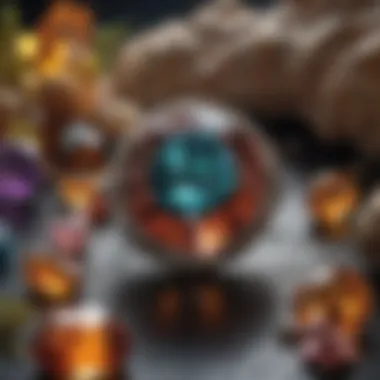
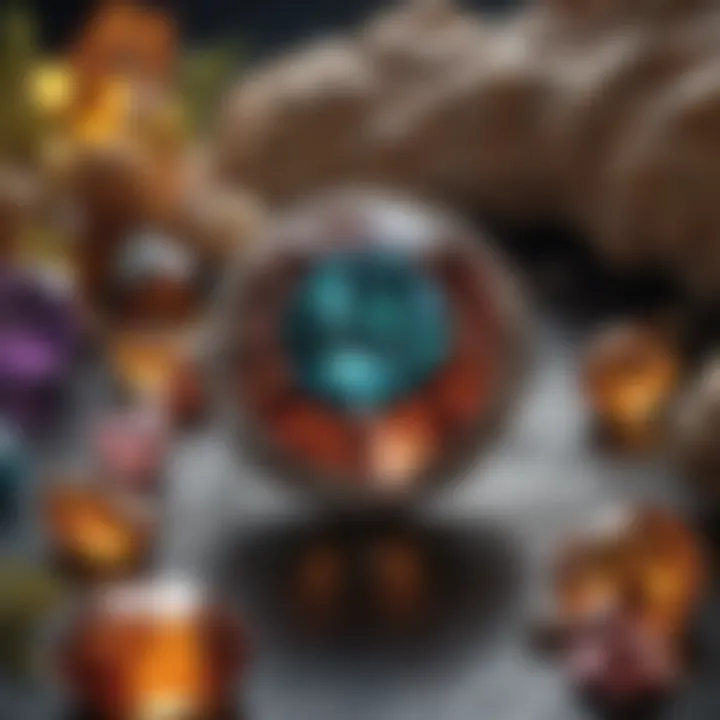
- Saturation: The deeper and more vivid the hue, the higher the value of the stone.
- Tone: The lightness or darkness of the color imparts additional characteristics to the stone.
- Hue: Different variations of basic colors, such as blue or green, can drastically affect the categorization of a stone.
Gemologists study these characteristics meticulously to determine quality and authenticity. Therefore, understanding how color impacts a sept stone connects collectors and consumers to the broader framework of gemological science, enhancing their appreciation of both the artistry and the intricacies behind each piece.
The Nature of Color in Gemstones
Color plays a pivotal role in the world of gemstones, serving not only as an aesthetic feature but also impacting classification, value, and cultural significance. When it comes to sept stones, the richness of color variations offers layers of meaning and symbolism that expand one's appreciation for these precious elements. Delving into the nature of color in gemstones enriches our understanding of sept stones and their unique story.
Understanding Color Theory
Color theory is the cornerstone of all art forms, and gemstones are no exception. This theory breaks down colors into primary, secondary, and tertiary hues, each creating a unique emotional and symbolic resonance. In the world of sept stones, the interplay of colors can evoke various feelings, guiding decisions in both design and selection.
- Primary Colors: Red, blue, and yellow serve as the fundamental building blocks for other colors. When considering sept stones, a vibrant red garnet or a deep blue sapphire can instantly captivate the beholder's attention, each evoking different emotional responses.
- Complement colors play a dual role in enhancing the charm of a stone. For instance, an emerald’s rich green hue may be offset by contrasting colors found in accompanying jewelry settings, creating visual interest.
- Warm and Cool Colors: Sept stones often fall into these categories—warm colors like amber and cool colors like sapphire. Warm colors tend to energize and can symbolize life, while cool colors often inspire calmness and introspection.
"Color is the keyboard, the eye is the hammer, the soul is the piano with many strings." - Wassily Kandinsky
Understanding these basic principles allows gemstone enthusiasts and designers alike to appreciate the depth of meaning behind the hues of sept stones.
Role of Color in Gemstone Classification
The classification of gemstones largely hinges on their color characteristics. Gemologists employ a grading system that includes hue, tone, and saturation to assess the quality and value of a gem.
- Hue: This refers to the pure color itself, such as the vibrant greens found in peridot or subtle pinks in rose quartz. A gemstone's hue can define its market positioning.
- Tone: This is about how light or dark the color appears. A lighter tone can indicate a lower value while a deeper, richer tone often commands a higher price.
- Saturation: This term describes the intensity of the color. A deeper saturation typically signifies a more valuable gemstone.
In the context of sept stones, color classification not only helps in identifying the stone but also informs collectors and buyers about its overall quality and worth in the market.
Optical Properties of Sept Stones
The optical properties of gemstones define how they interact with light, playing a significant role in their allure. Sept stones, with their diverse color range, exhibit unique properties that can influence their perceived beauty and, consequently, their value.
- Transparency: Some sept stones are transparent, allowing light to pass through them. This quality amplifies their color, making it appear more vibrant. For example, a clear aquamarine will display its light blue hues brilliantly when viewed in sunlight.
- Reflectivity: The way a stone reflects light is crucial. Stones with high reflectivity, such as diamond, can create a sparkly allure that others might lack. Consider how a well-polished black onyx can appear glossy and mesmerizing.
- Color Play: Certain sept stones, like opals, display a phenomenon known as play-of-color, where multiple colors emerge depending on the angle of light. This complexity adds to the stone's appeal, tantalizing those who gaze upon it.
Through understanding the optical properties of sept stones, collectors and enthusiasts can grasp why some stones dazzle more than others. Being aware of these attributes can enhance one’s appreciation for the subtleties unique to each gem.
Color Variations in Sept Stones
When discussing sept stones, their color variations not only capture aesthetic interest but also carry significant meanings and implications. This section serves as a cornerstone for our understanding of how color influences the identity of sept stones, showcasing why these nuances are important for gem enthusiasts, collectors, and jewelry designers alike. The beauty of these gemstones lies not just in their physical allure but in the stories and energies each color invokes.
Common Colors and Their Meanings
Each shade associated with sept stones has its own distinct narrative, often rooted in cultural significance and personal connection. Here, we explore some widely recognized hues:
- Blue: Often associated with calmness and harmony, blue sept stones evoke a sense of peace. Historically, they’ve been linked to wisdom and truth, making them cherished for their spiritual properties.
- Green: Typically a symbol of growth and renewal, green stones can signify balance and healing. Many cultures believe these hues enhance one's connection to nature.
- Red: Known for representing love and passion, red colors can inspire strong emotions. They hold the connotation of strength and energy, making them highly sought-after.
- Yellow: This bright color is frequently tied to joy and enlightenment. Yellow sept stones reflect optimism and creativity, often sought after by those looking to engage more with their artistic side.
"Colors can tell stories that words sometimes cannot. Understanding them provides a deeper connection to the stones we cherish."
Rare Color Occurrences
While common colors have their place in the conversation about sept stones, it’s the rare occurrences that truly captivate. Unusual hues can elevate a gemstone's status, turning it into a prized possession:
- Violet: Rare and enchanting, violet stones not only have a regal appeal but also are believed to enhance intuition and spiritual awareness.
- Black: Often misunderstood, black sept stones can signify strength and protection. They may be scarce, yet their boldness resonates deeply with those drawn to impactful energies.
- Color Shifts: Some sept stones display phenomena where their color changes depending on light exposure. This optical marvel represents adaptability, and these varieties are often sought out for their unique beauty.
Impact of Color on Value
Color plays a pivotal role in determining the value of sept stones. When it comes to gemstones, the vibrancy and rarity of a color can greatly influence market demand. Here are key factors to consider:
- Richness: A strikingly vivid color often fetches a higher price than a muted version. Collectors seek stones that embody clarity and saturation.
- Rarity: The less common the color, the more valuable the stone typically becomes. This rarity can create an emotional allure, driving enthusiasts and investors alike to seek them out.
- Historical Context: Some colors may have ancient traditions or meanings tied to them. This connection can enhance a stone's value significantly, as buyers might be drawn to its story just as much as its appearance.
In summary, the color variations found in sept stones are significant, capturing attention far beyond surface beauty. They open dialogues about values, traditions, and personal connections, enriching our appreciation for these remarkable gemstones.
Cultural Perspectives on Sept Stone Color
Understanding the cultural perspectives on sept stone color offers a rich tapestry of meanings that extends beyond mere aesthetics. Each shade, hue, and tint often carries significant implications, shaping beliefs, traditions, and emotional connections across diverse societies. This section serves to unravel the layers of symbolism tied to colors of sept stones, as well as their role in spiritual and traditional contexts.
Symbolism Across Cultures
Colors in sept stones act as conduits for cultural significance, with their meanings often deeply ingrained in societal narratives. For instance, in many Indigenous cultures, stones with red hues might symbolize life and vitality, often associated with the blood that flows through one's veins. Conversely, the blue stones are frequently seen as symbols of tranquility and peace, reflected in various artistic expressions and folklore.
- Yellow Sept Stones: Commonly symbolize optimism and warmth, they are often incorporated into celebrations as harbingers of joy.
- Green Stones: Often connected to growth and prosperity, these gems find a place in various rituals meant to attract wealth and bounty.
Within many Asian cultures, the color black is often linked with wisdom and protection, whereas white may symbolize purity and the divine. Each culture tends to weave these meanings into their narratives, thus enriching the overall understanding of sept stone colors across different contexts.


"The beauty of sept stones is not only in what they reveal to our eyes but also in the stories they tell through their colors."
Color and Spiritual Significance
The spiritual dimensions of color in sept stones are equally compelling. Many individuals believe that the colors of these stones resonate with various energies that can influence one’s spiritual journey. For example:
- Purple is often regarded as a color of spiritual awakening, associated with intuition and higher consciousness.
- Orange is viewed as invigorating, fostering creativity and motivation on one’s path.
People often seek specific sept stones during meditative practices, aligning their personal intentions with the perceived energies of each color. This practice emphasizes not only the stones’ appearances but also their purported ability to enhance spiritual growth and personal development.
In some cultural traditions, these beliefs in spiritual significance play a substantial role in gemstone therapies, where practitioners use colored stones to unblock energies or elevate one’s mood.
Influence of Color on Traditions
The influence of color on traditions cannot be understated when discussing sept stones. Many cultural practices revolve around these stones during significant life events. The colors chosen for weddings, funerals, or celebrations can reflect societal values and beliefs.
For instance, in Hindu culture, vibrant red stones such as rubies may be favored in wedding ceremonies, symbolizing love and passion. Meanwhile, in some African communities, color significance can dictate roles within ceremonies.
- Colors Associated with Celebration: • Gold represents wealth, prosperity, and the divine • Green is often seen as a symbol of life.
- Colors Linked to Mourning: • Black is generally worn to signify loss, whereas white is often used in some Eastern traditions as a color of remembrance.
As you can see, the colors of sept stones resonate deeply within cultural practices, intertwining aesthetics with spiritual, social, and historical meanings. Understanding these cultural perspectives is essential for anyone aiming to appreciate the nuances within the world of gemstones, offering a view that is at once enriching and enlightening.
Metaphysical Properties of Sept Stone Colors
The metaphysical properties of sept stone colors offer a fascinating lens through which to view the significance of these stunning gemstones. Each color isn’t just a visual appeal; it carries its own vibrational energy and implications for the wearer or possessor. This dimension of stone color might be seen as an invisible thread intertwining aesthetics with emotional and spiritual resonance.
Healing Attributes
Many enthusiasts believe that sept stones hold specific healing attributes due to their color. For instance, blue stones like Lapis Lazuli are often associated with serenity and inner peace, helping to calm the mind. On the other hand, red stones like Garnet are thought to energize and invigorate the spirit, inspiring motivation. People who turn to these stones sometimes seek to heal not just physical ailments but emotional and spiritual ones too. It’s said that wearing or meditating with these stones can promote feelings of clarity and purpose.
- Calming Colors: Blue hues are known for promoting tranquility.
- Energizing Stones: Reds and oranges often inspire action and enthusiasm.
- Balance and Grounding: Earth tones, like greens and browns, are linked to stability and rootedness.
"Color is the keyboard, the eyes are the harmonies, the soul is the piano with many strings."
-Wassily Kandinsky
Color as an Energy Influencer
Colors undoubtedly influence mood and feelings. In the metaphysical realm, this is no different. Different colors are believed to emit various forms of energy that can affect one’s mental state or spiritual awareness. For instance, a yellow sept stone may invoke feelings of happiness and optimism, making it ideal for creative endeavors or social gatherings. Conversely, darker colors like deep purple can promote contemplation and deepen one's connection to the spiritual realm.
When it comes to utilizing these properties, some people choose to align their stone with their intentions.
- Yellow: Brings joy and triggers creativity.
- Green: Encourages abundance and prosperity.
- Purple: Enhances spiritual awareness and intuition.
Personal Connection to Colors
Understanding the personal connection to colors is vital in the exploration of sept stones. Everyone resonates differently with specific hues based on their personal experiences, culture, and even psychology. One person might find peace in a blue Sapphire, while another finds joy in the fiery tones of a red Agate. This interplay can shape one’s identity and how they relate to the world around them.
For collectors and enthusiasts, choosing a stone is often a deeply personal experience. It’s not just about value or aesthetics — it’s about a connection that provokes feelings, memories, and aspirations. Recognizing which colors resonate personally not only fosters a deeper appreciation of the stone itself but can enhance the metaphysical experience when wearing or using it.
Ultimately, the metaphysical properties tied to the colors of sept stones explore a rich tapestry of healing, energy influence, and personal connections that elevate their significance far beyond mere ornamentation.
Sept Stones in Jewelry Design
The realm of jewelry design is a fascinating combination of artistry and technical prowess, and sept stones play a crucial role in this delicate balance. The diverse colors and intricate patterns of these stones do not merely serve aesthetic purposes; they resonate with deeper meanings and implications that can elevate a piece from ordinary to extraordinary. The importance of understanding the specifics of sept stones cannot be understated, particularly in how they can enhance jewelry pieces both visually and symbolically.
Color Selection in Contemporary Jewelry
When it comes to selecting colors in contemporary jewelry designs using sept stones, there are several factors at play. Designers frequently consider trends, personal taste, and the emotional resonance that colors invoke. For instance, a deep blue lapis lazuli can signify wisdom, while gentle greens may evoke tranquility. Choosing these colors thoughtfully isn’t just about aesthetics; it can steer the narrative of the piece itself.
In a society increasingly attuned to meanings behind colors, incorporating gems like red garnets or yellow citrines can infuse designs with passion or positivity, respectively. Modern consumers often seek pieces that reflect their identity or journey, making color a pivotal element in the selection process.
Combining Colors in Designs
The art of combining colors in jewelry design is akin to conducting a symphony. Each color, like a musical note, can either create harmony or discord. Pairing different sept stone colors can result in breathtaking contrasts or soothing blends. For example, a rich purple amethyst combined with *soft pink rose quartz can produce a beautiful interplay, blending the energies associated with love and peace.
Designers frequently experiment with combinations to enhance visual depth and attraction. Certain arrangements, such as stark contrasts alongside subtle tones, can draw attention to specific components of the design, leading the viewer's eye through the jewelry piece. However, it is crucial to remain mindful of the symbolic meanings associated with each color, as mismatches can deliver unintended messages.
Trends in Sept Stone Jewelry
Current trends in sept stone jewelry reflect a broader movement toward personalized, meaningful adornments. Rather than merely being decorative, jewelry is now viewed as an extension of one’s self and story. Popular trends encompass statement pieces featuring large, uniquely colored sept stones, as well as layered and stacking techniques that allow individuals to express their style through combinations.
- Bold Statement Pieces: Larger sept stones are gaining traction, making them the focal point of necklaces, rings, and earrings.
- Sustainable Choices: Interest in ethically sourced and sustainable sept stones continues to rise, with consumers looking for authenticity in their purchases.
- Customization Options: Personalized designs tailored to individual color preferences and symbolic meanings are on the uptick, further enhancing the connection between the wearer and the piece.
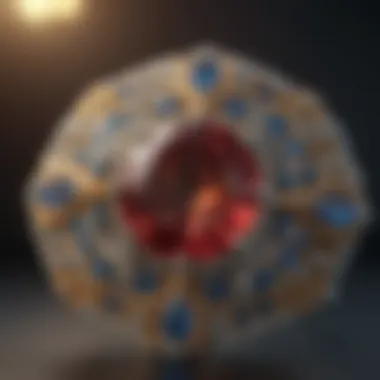

In a crowded marketplace, understanding these trends can provide an edge for designers searching for inspiration. An engaging piece that marries timeless significance with contemporary design sensibilities may well capture the imagination of discerning collectors and enthusiasts alike.
"The color of the stone can say so much about the piece before the wearer even lays eyes on it."
In sum, poking into the significance of color in sept stone jewelry design delivers insights about both fashion trends and deeper messages behind personal adornments. Whether through the intricate process of selecting colors or the inventive combinations that come to life, sept stones continue to influence the path of modern jewelry making.
Maintenance and Care of Colored Sept Stones
Taking care of colored sept stones isn’t just a matter of keeping them pretty; it's about prolonging their life and preserving their unique characteristics. This section looks into vital practices that collectors, jewelry designers, and enthusiasts should heed to keep their gems in tip-top shape. By staying on top of these maintenance tasks, you're not only retaining the beauty of your stones but also their value.
Cleaning Guidelines
When it comes to cleaning sept stones, a gentle touch goes a long way. Each stone has its own set of vulnerabilities, and knowing how to treat them is crucial. Most colored sept stones can suffer from scratches or damage if cleaned improperly.
- Mild Soap and Water: A mixture of warm water and a few drops of mild soap can do wonders. Just dip a soft cloth or a soft-bristled toothbrush in this solution and lightly scrub the surface. This method is particularly suited for stones like turquoise or agate.
- Avoid Harsh Chemicals: It’s wise to steer clear of bleach or acidic cleaners. They can strip away the finish, dulling the surface and potentially harming the stone.
- Dry Properly: Always make sure to dry the stones thoroughly after cleaning. Leaving moisture can lead to unwanted tarnish or cloudiness.
"The care you give your sept stones now is an investment in their future. Treat them well, and they will serve you for a lifetime."
Storage Recommendations
Storing your colored sept stones correctly can be just as important as the cleaning routine. Improper storage might lead to scratches or even breakage. Here are a few tips to ensure safe storage:
- Individual Pouches or Clasps: Store each stone separately in soft pouches made of silk or velvet. This shields them from scratches.
- Avoid Direct Sunlight: Prolonged exposure to sunlight can fade certain colors over time. A dark drawer or a jewelry box is ideal.
- Temperature Control: Extreme temperatures can affect the stone’s integrity; it’s best to avoid places like attics or basements.
Preservation of Color and Quality
Color preservation is a chief concern for anyone dealing with colored sept stones. After all, vibrant hues often dictate their value and beauty. Here are some things to consider:
- Limit Exposure to Chemicals: Be it perfumes, lotions, or even household cleaners, reduce the contact of your stones with such products. Chemicals can lead to fading or discoloration.
- Regular Inspections: Take the time to inspect your stones periodically. Check for any signs of wear, cracks, or color changes. This way, you catch any premature deterioration before it gets worse.
- Professional Help: If you have high-value stones or are unsure about their care, consider reaching out to a professional gemologist. Their expertise can help maintain the integrity and color of your collection.
By adopting these maintenance practices, you're not just protecting your sept stones, but also cherishing the stories and meanings they carry. A little care goes a long way to ensuring that their beauty and significance live on.
Future Trends in Sept Stone Appreciation
The appreciation of sept stone colors is poised for evolution, driven by shifting consumer preferences, advances in technology, and a growing awareness of sustainability. This part of the article delves into the future of sept stone colors, underlining key trends that gemstone enthusiasts, collectors, and jewelry designers should keep an eye on.
Emerging Color Trends
In the world of gemstones, color is not just an aesthetic choice; it serves as a powerful narrative. Emerging color trends in sept stones reflect broader societal moods and preferences.
- Seasonal Colors: Some gemstones gain popularity as color palettes change with the seasons. For instance, warmer hues like amber and muted reds might see a surge in autumn, whereas cooler blues and greens can dominate in spring.
- Taste Changes: As modern designs lean toward minimalism, potently vibrant colors such as intense pinks or deep violets might appeal more to those valuing subtle elegance. Designers are adapting, too, experimenting with unexpected color pairings that contrast with traditional choices.
- Cultural Influences: Color trends also reflect cultural inspirations. A rise in interest might come from movies, celebrity endorsements, or significant events in fashion. For instance, the blue of the ocean might translate to a renewed interest in aquamarine or topaz, as buyers seek stones that echo the tranquility of seaside escapes.
Technological Advances in Gemstone Assessment
Technology has been a game changer in gemstone appraisal and trading. With advancements in tools and methods, the way we assess sept stones is changing drastically.
- Digital Imaging: Enhanced imaging techniques allow gemologists to be more precise in identifying color variations and quality. High-resolution images can capture subtle differences that the naked eye might miss, aiding both collectors and jewelers in making informed decisions.
- Blockchain Technology: As the market leans towards transparency, blockchain offers a method to track the origins and journeys of sept stones. This can build trust and authenticity in transactions. Customers value knowing where stones come from, reducing chances of conflict or unethical sourcing.
- Virtual Shopping: With online platforms becoming more prevalent, augmented reality allows buyers to visualize how stones will look in different settings before purchase. This helps in making choices that align with individual tastes and the current trends in sept stone designs.
Sustainability and Ethical Sourcing
As awareness grows regarding environmental and social issues, sustainability is becoming integral in gemstone appreciation. Here's how:
- Eco-Friendly Practices: Many collectors seek stones that are sourced from ethical mines. The focus is now on stones that do not contribute to environmental degradation. Sustainable mining techniques preserve habitats while ensuring that the local communities benefit.
- Recycled Gems: Using previously owned gemstones is on the rise. This trend promotes recycling and reduces demand for newly mined stones, appealing to eco-conscious consumers who appreciate the stories behind these gems.
- Transparency in Sourcing: Consumers are becoming more discerning. They demand to know not only where their stones are sourced but also how miners are treated. Companies that emphasize fair wages and safe working conditions are becoming more sought after.
"The future of sept stones lies in their stories—how they are sourced and the colors that resonate with personal journeys and cultural heritages."
End: The Lasting Impact of Color in Sept Stones
The concluding section of this article emphasizes the pivotal role of color in understanding sept stones. It serves as a reminder that color is not just a superficial characteristic; instead, it infuses gems with meaning, history, and value that drives their appreciation in both personal and societal contexts. The significance of sept stone color can be dissected into several layers, which range from aesthetic appeal to cultural depth and emotional resonance.
Summarizing Key Insights
In reviewing the myriad aspects of sept stone color, it becomes clear that the implications extend beyond mere visual enjoyment. Some of the key insights include:
- Cultural Value: Different colors resonate within diverse cultures, allowing stones to be symbols of beliefs, rituals, and traditions. For instance, blue sapphires are often linked to wisdom in various cultures.
- Psychological Impact: Colors evoke emotional responses. A stone's hue can influence mood, encourage contemplation, or even represent life milestones.
- Market Dynamics: Color affects rarity and, consequently, the monetary value of gemstones. Stones with unique colors are often more sought after, increasing their appreciation among collectors.
Ultimately, the interplay of these factors shapes how lovers of gemstones interact with their collections and what meaning they ascribe to their cherished pieces. The appreciation of color in sept stones can be viewed as an art form, where the aesthetic and the emotional converge to create a complex tapestry of value and connection.
The Emotional Connection to Color
The emotional bond that individuals form with color is deeply personal. Each hue may carry distinct memories or sentiments, creating a unique relationship between the wearer and their sept stone. Take, for example, a rose quartz. This gentle pink hue often evokes feelings of love and peace, making it a popular choice for those seeking emotional healing or fostering loving relationships.
"Color is like a language; it speaks to us in ways that words sometimes cannot."
Similarly, a vibrant green emerald may remind someone of the lush forests of childhood adventures or family gatherings during holidays. The personal stories behind these colors add another layer of value that transcends the physical properties of the stones. By embracing these connections, gemstone enthusiasts can cultivate a deeper appreciation for their gems.
To conclude, the lasting impact of color in sept stones is undeniably profound. It shapes how we perceive, interact with, and cherish these beautiful creations of nature. Whether one is a collector, designer, or simply an admirer, recognizing the implications of color enriches our experience, transforming the contemplation of gemstones into a journey through culture, emotion, and history.



